|
Fake zippo's
In
1982 Japanese businessmen came in Vietnam to
spend a good time with hot girls. A Chinese
merchant with extensive connections in the Saigon
Government was able to get "concessions"
and controlled much of the actual lighter business.
He has discovered the attractive appeal of the
Zippo to the tourist looking for the exotic.
The more the sentence engraved into the lighter
was bawdy, more they bought it. Americans left
thousand of new plain Zippos when they withdrew
and this merchant recuperated them through his
familiar network. The old templates and pantograph
machines were used to engrave old/new Zippos.
Since,
I have received this
information from a passionate
witness by the Vietnam zippo history. I give
it to you as he wrote it.
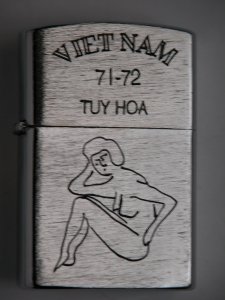  
Engraving
done for these tourists
In
the early in 90's, the tourism to Vietnam increased
when diplomatic relations relaxed between the
USA and Vietnam. The veterans were the first
looking for Vietnam Zippos, part of their memory
but mainly their youth. The market turned into
a business for young Vietnamese dealers of Saigon
and soon fake Zippos came to the market. After
the collapse lighters and quite a few items
were stashed. The gold and jewellery was used
as exchange to "get out" and over
the past few years they have surfaced as negotiable
items.
Three
categories of fake zippos were engraved in Vietnam.
1)
Real zippos with fabrication marks after 1975
Vietnam engraved.
2) Real zippos with correct date marks (before
1975) with Vietnam engraving added at a later
date.
3) And then completely counterfeit zippos with
engraved zippo mark on the bottom and on the
insert.
To
detect the zippos from the first category check
the zippo date according to the dating card
supplied by the zippo firm. For the years between
1966 and 1975 (Vietnam war ended in April 1975)
the codes are: four vertical bars each side
of the italicized zippo logo for 1966. Then
the bars were removed alternatively first on
the right and then on the left. So for 1967
four bars on the left and three on the right,
three each side for 1968 and so one until 1973
last year with vertical bar coding. Lighters
from 1973 have one bar on the left and nothing
on the right. In 1974, the code marks turn to
slashes; four slashes on each side of the italicized
zippo logo and in 1975 only three slashes on
the right part. Confused? Read this chapter
carefully, and compare with the zippo chart.

Code
mark on a 68's lighter
Examination of the insert.
Another
way to detect the counterfeit is to examine
the text on the insert. Only one face must be
inscribed in horizontal position. In the three
lines at the top of the insert: FOR BEST RESULTS
USE ZIPPO FLINTS AND FLUID and at the bottom:
ZIPPO MFG, CO. BRADFORD. PA. ZIPPO ® MADE IN
U.S.A. also in three lines.

All
zippos made from November 1932 could be engraved
in Vietnam. American soldiers have adopted them
since the Second World War and from this period
soldiers have engraved their names, battle sites
and feelings onto their lighters.
Most
lighters from Korea war have the 2032695 patent
number stamped on the bottom. The lighter is
made of steel with chrome plated instead of
brass with chrome plated.


1952
zippo lighter (Korea war)
From
1955 to August 1967, PAT. 2517191 was etched
under the italicized zippo logo and at the lower
part of the inscription in the insert. As the
new press machine was introduced, the indent
of the bottom became deeper in 1969 and the
typeface of "Z" in the zippo logo
was changed. The trademark '®' was moved to
the 'O' of the ZIPPO, the wick eyelet is different
and the cam spring is larger.


New
copies engraved bottom (code 1966). Pressed
bottom (code 1967). Note the type face of "Z"
like the 1969 code.


1969
code, the fake is on the left. Note the position
of the trademark '®'
under the "O".
67
ZIPPO Code


Both
zippo codes below are fake example that you
could find nowadays. The fabrication date is
1967, before August for the one with the patent
number and after August for the other. The bottom
is deeper embossed than the genuine 67 zippo.
This will append in 69 when zippo modify the
press machine. On the first, the top part of
the "Z" start under the "R"
of BRADFORD and the coma is between the "Z"
and the "I" of zippo.
On
the second, the ® is below the "O"
of zippo like 1969 zippo code. The italized
word zippo
is centred (lower position). It was impossible
because zippo have ground the patent number
off the old dies and then used the old dies
to code the bottom until mid 1969.
Above
a genuine 1967 zippo code for comparison.

Zippo
used a new machine press in 1969 which caused
the "canned" bottom of the lighter
to be more dented in. Also zippo changed the
"Z" logo and gave the letter "Z"
a tail hanging down on the right side. The ®
is now above the "O" of zippo . The
"Z" start above the "R"
of Bradford and the logo is centred.

Genuine zippos and new engravings
When
American soldiers withdraw from Vietnam in March
1973, they left a considerable quantity of materials,
tanks, planes, patrol boats and of course a
lot of mint in box Zippos. On the Khe San base,
Vietnamese dug up a Caterpillar buried under
the landing track.
All the new Zippos left have been recuperated,
engraved and sold in the markets of Da-Nang,
Hue or in the Chinese market of Cholon at Saigon.
It is very difficult to detect this kind of
counterfeit; only the type of engraving and
the new shiny filling to the engraving can help
to detect them. None of the engravers of the
wartime had added filling to their engraving
excepted those in mint or close to mint condition
purchased on the way home in Saigon or Tan Son
Nhut airport. Filling would have succumbed to
the wartime fluid.
The best way to refill a lighter was to plug
it into fuel tank, jeep, plane, boat or truck
hanging from a wire. After this treatment, the
filling would have been eaten off.
The thorough examination of the form in the
lettering can help you to detect the engraving
added after the war period. So thinking adding
value to the lighter, Vietnamese have added
engraving on all parts of the lighter. The used
font is different on the body from that on the
lid or the engraving doesn't penetrate deeply
into the brass.
The easiest fake engravings to detect are those
about well-known events. The famous "IF
I HAD BEEN AT KENT STATE THERE WOULD HAVE BEEN
ONE HELL OF A BODY COUNT". May 4 1970,
National Guard kills four students at Kent State
antiwar protests. Real Zippo with 67 or 68 engraved
on the lid have this sentence concerning facts
that would happen two or three years later.


67-68
engraved on the reverse lid
Another
means consist to verify the relation between
the date, the place and insignia engraved onto
the Zippos. Silver Bayonet operation had implied
the 1st Cavalry Division in the Pleiku province
from October until November 1965. This operation
is known as the Ia Drang Valley Battle. The
movie we were soldiers relate it. The insignia
of the 3rd Brigade GARRY OWEN and the place
Ia Drang must be found only on a Zippo with
date code above 1966.
An engraved lighter with
LLDB in front and "BORN IN AMERICA TO DIE
IN VIETNAM" on the reverse is a fake. LLDB
(Luc Luong Dac Biet) were Special Forces of
the South Vietnam army. Americans called them
Lousy Little Dirty Bastards; nobody from them
was born in USA to die in Vietnam.
The
word VIETNAM on a lighter from Khe Shan, Da
Nang, or Kontum can't be the same. Vietnamese
engravers could not communicate with the others
except maybe at Saigon. It was impossible for
them to circulate form province to province.
Cities were under the control of the army but
the roads were under the control of the Viet
Cong.
Engraved texts could help you to detect fake
Zippos. The famous I HAVE SPENT MY TIME IN HELL
was well known and there is no confusion about
it but it is the most copied. The variants are:"
I am sure to go to heaven"; "I know
I am going to heaven" and "I will
go to heaven".
The Vietnam map engraved in Nha Trang in 1972
or Hue in 1968 can't look like the one engraved
in Saigon in 1966.



The
same font used for three diferent places
After
the fall of Saigon, the North Viet Nam system
changed the old Chinese
name of many cities.
Nowadays, Pleiku is turned to Plaiku, Quinhon
to Quy Nhon, Dak To to Dac To Ban Me Thuot to
Buon Ma Thuot and so. A lighter with a new city
name is a forgery.
Fake
PBR
Nowadays
Zippos with Brown River acid etched are presented
daily on the web. Prized and rare, those lighters
have inspired the forgers and since many years
these lighters came to the market. Zippo had
perfected the "etch and paint" process
in 1957 for cars advertising. It allowed more
detailed designs than was possible using the
pantograph. The process used by Zippo is based
on the artwork, a large drawing realized on
the drawing board. A reverse image of the artwork
is screened onto the case with acid-resistant
paint. The lighter is then dipped into an acid
bath that etches the unprotected areas. The
resulting recesses are then filled, one by one,
with color.
The drawings used to produce the films are the
property of Zippo MFG. So the forgers have to
remake the whole process. I have discussed with
some sellers about fake PBR and the answers
were funny. They said: It was special orders
sent to local craftsmen by the PX/BX and then
refused because the etching was not sharp enough
to add the paint. They were kidding.
I have contacted some vets working at the PX
and they answered: "While canned beer and
soft drinks are hardly perishable, hot and dusty
base area makes them number one on the PX's
best-seller list. On one re-supply day, the
exchange received more than $5,000 worth of
refreshments. Within twelve hours after it had
been unloaded, the stock of drinks had been
delivered to the brigade's units. "Our
goal is to give the man in the foxhole anything
he wants at anytime day or night". Imagine
50 Zippo lighters, retail price $1.75, is nothing
according to $3,000 shipment of chewing gum.
No time to ask for special order but sometimes
units would send directly to Zippo an order
of 50 or 100 lighters with a special unit or
branch design".
Although Konwal and Penguin PBR engraved lighters
exist. They are not etched but pantograph engraved
and the patch on the reverse is glued in lieu
of etched. The PBR boat design is different
than the Zippo artwork.
I have seen many PBR Zippos with on the observe
face River Division 554 and on the reverse River
Section 511. The River Section 511 was located
at Can Tho near the Bassac river (Mekong Delta)
and the Division 554 at Da Nang.
Ray,
a crewmember of the 523 PBR, The Delta Gypies,
told me that:
They
are shooting bull your way about special order.
During my two tours, I never encountered a special
order sent to local. Lighters were dispursed
to the PX in small numbers and were sold out
quick. I did purchase three Zippos when I was
in country. The PX were located on the LST that
where anchored in the large rivers, where you
could get the lighters then take them to a local
artist to do the engraving. Every one could
get one or more Zippos at this time.

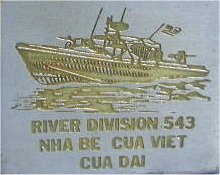
Very
rare "Brown Water Navy" (used by Mekong
patrol) from 1967. The left is a copy


Costal
Division Eleven The left is a fake (Notice NUMBER
instead of NUMBAH)
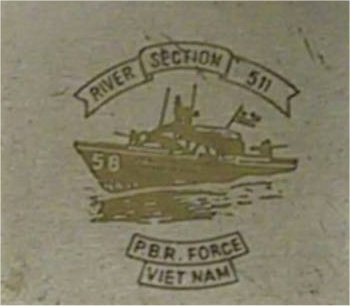
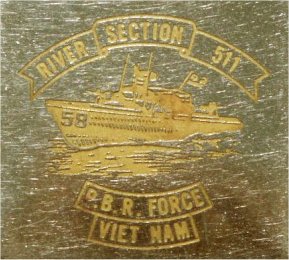
River
Section 511, the left is a copy. Notice the
banner is larger as the boat on the real.
Counterfeit Zippos.
The
lighters from this category are very easy to
detect because the zippo logo on the bottom
and on the insert is engraved instead of stamped.
Nevertheless there is a particular category
with stamped date code but the zippo logo looks
like 1969 factory stamp with the trademark ®
larger and rougher.
Look
closely for abrasive marks (using a loupe).
To enhance their aged look, genuine zippos have
been distressed. The older it looks, the more
money it fetches in the market. Do not confuse
fine age marks with sandpaper marks.
Themes
engraved on the lighters can help you to detect
the counterfeits. So, no Mickey companions were
engraved on genuine wartime zippo lighters.
Only Charles Shultz cartoons, Snoopy on his
doghouse and Charlie Brown were engraved. The
Peanuts appeared in the newspapers Stars &
Stripes and The Times of Viet Nam.
Remember
the first method to detect the counterfeits
is to check the fabrication date codes at the
bottom of the lighter. The forgers know all
about GI's zippo history because they have held
them to make copies. The engravings and poetries
engraved on counterfeit lighters are correct.
The places, the dates, military emblems and
even soldier's name are correct.

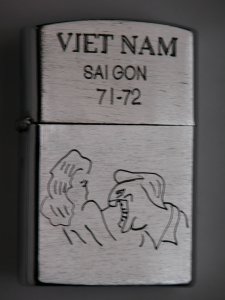

Chinese
lighters actually for sale in Saigon.
How to detect counterfeits
If
the engraving is filled with new shiny black
or brown ink beware! Remember none engraver
had filled the lighter that he had just engraved
excepted those, new in box, sent to the family
as a gift. The wet and humid climate would eat
up the filling.

Here
how would look a Vietnam engraving. The brass
is tarnished and the colour must be dark brown.
A new engraving is shiny yellow or filled with
black china ink.
If
there are some scratches on the lighter, the
scratches should affect the engraving (look
closely with a x 10 loupe).
The
market tendency is for old aged look lighter.
To give this particular look the forgers distress
the lighter with sandpaper. If the entire surfaces
are distressed beware, the lighter is should
be a new engraved one. You should examine the
zippo and the engraving itself rather than the
distressing.
Another
method to have this particular look is to burn
the lighter with a blowlamp. In this case there
is a concentration of the copper at the surface.
In the metallurgical process to have chrome
plated on the brass, it is necessary to plate
the brass with copper before chroming process.
Genuine
zippos were found fully burnt in the trash of
ancient military bases but in this case the
rayon balls and the felt pad of the insert were
also burnt. The insert had to be exchanged so
beware of this kind of lighters.

Burnt
Zippo to enhance his value.
The
date engraved on the lid according to the unit
insignia is a good method of detecting counterfeit
in this category. Recently, someone asked for
an advice about a Chu Lai 65-66 196th
Inf Bde Zippo. The 196th was
originally rushed to Vietnam in Tay Ninh province
(26 August 66), in April 67 the brigade moved
to Chu Lai until October 67 and Tam Ky, Phong
Dien and Hoi An before to return to Chu Lai
from July 68 to March 71. In April 71 the brigade
was relocated to Da Nang until its departure
29 June 1972. The major part of its tour was
Chu Lai, so the Vietnamese have this location
in their minds. Naturally, they associate the
196th with Chu Lai. This was in 65-66
nobody knows the next location of the 196th.
The correct place should be Tay Ninh on the
lid of this lighter. This lighter was recently
engraved and the owner was angry about me. He
doesn’t accept my conclusions.
So
any way, an other lighter with the 198th
Bde attracted my interest. The date 72-73 and
the place Quang Tri were fantasists. The 198th
was located at Chu Lai and mainly it leaves
Vietnam in November 1971. I had a look at the
composition of the brigade to be sure of not
omitting any battalion or units but every unit
leaves Vietnam between May and November 1971.
In 72-73 Quang Tri garrison was the 3rd
ARVN Inf Div. Since I had to give an advice
about many lighters and every time that I have
a doubt, the lighter was recently engraved.
25th
Inf Khe Sanh 65-66 (arrived 28 march 1966, the
3rd bde arrived December 65 at Pleiku)
1st
Marines 64-65 Vinh Long (Mekong delta)
9th
Inf Div Tay Ninh 67-68 (the 25th
Div at this time)
4th
Inf Div 64-65 Pleiku (arrived 26 September 1966)
173rd
Air Borne Dak To 72-73 (departed 25 August1971)
101st
Air Borne Vinh Long 68-69 (Only the 7th Bat
1st Cav was at Vinh Long at this time)
5th
Bat 46th Inf Cu Chi 69-70 (in 69-70 at Chu Lai
with the 23rd Inf Div AMERICAL)
82nd
Airborne Khe Sanh 64-65 (arrived 18 February
1968 at Chu Lai)
Vietnamese
Workshop today
When
I was in Vietnam for my second tour, a couple
of years ago, I bought a copy with the screaming
eagle of the 101st. I bought it from a catalogue
showing all kinds of design. I chose to engrave
my own zippo with a Vietnam map and on the back
"WHEN I DIE I KNOW I AM GOING.......".
The cost for this job was only 2 US dollars.

My
dailly zippo, the stamped code is E ZIPPO 01
I bought 5 zippos with
the correct date and correct insert matching
them for 15 US dollars each. I had to stay 10
days in Saigon and every night after traveling,
I met the seller drinking tea and talking about
everything. I shared with her my interest for
old zippos and I gave her a book about zippos.
She was kind enough to permit me to visit a
little shop where young Vietnameses engraved
copies for tourists.
I saw a lot of plain zippos from the war area
in new condition with the original packaging.
I saw a lot of old zippos with old engraving
and the Vietnameses were added on the lid "VIET
NAM "and the date matching the date code
of the lighter. I asked her if I could buy real
zippos from wartime, she answered
"Bob,
all are from the war time, only the engraving
is new . A real one with old engraving costs
about 60 US dollars and no tourist wants to
pay for that excepted American vets. They are
looking for the one they have paid for at the
tea room or lost in a bar when drunk enough
to sleep on the table or lost in the field during
fighting."

Zippo
from Miss Beauty private collection
She
took her Honda and rode me to her house. I met
all of her family and had a discussion with
her mother about France. She presented me her
own collection. There were few Barcroft table
lighters with PBR factory etched and a lot of
zippos with Indochina map in a circle with the
name of USS ship plus South Vietnam and the
date. I bought two Snoopy's with no shiny filling
into the engraving , and no VIET NAM on the
lid.
Her
shop is located Dong Khoi street 1st. District.
Dong Khoi street is the new name for Catinat
street during the French period and Tu Do street
from 1964 to 1975. The street starts from the
cathedral to Saigon river. My hotel was at the
corner of her shop.
|